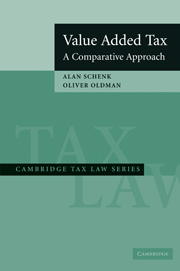Book contents
- Frontmatter
- Contents
- List of Tables, Figures, and Charts
- List of Cases
- Preface to the Revised Edition
- Value Added Tax
- 1 SURVEY OF TAXES ON CONSUMPTION AND INCOME, AND INTRODUCTION TO VALUE ADDED TAX
- 2 FORMS OF CONSUMPTION-BASED TAXES AND ALTERING THE TAX BASE
- 3 VARIETIES OF VAT IN USE
- 4 REGISTRATION, TAXPAYER, AND TAXABLE BUSINESS ACTIVITY
- 5 TAXABLE SUPPLIES OF GOODS AND SERVICES, AND TAX INVOICES
- 6 THE TAX CREDIT MECHANISM
- 7 INTRODUCTION TO CROSS-BORDER ASPECTS OF VAT
- 8 TIMING, TRANSITION AND VALUATION RULES
- 9 ZERO RATING AND EXEMPTIONS AND GOVERNMENT ENTITIES AND NONPROFIT ORGANIZATIONS
- 10 GAMBLING AND FINANCIAL SERVICES (OTHER THAN INSURANCE)
- 11 INSURANCE
- 12 INTERJURISDICTIONAL ASPECTS OF VAT IN FEDERAL COUNTRIES AND COMMON MARKETS
- 13 REAL PROPERTY
- 14 PROPOSALS FOR U.S. TAX ON CONSUMPTION
- APPENDIXES
- Index
5 - TAXABLE SUPPLIES OF GOODS AND SERVICES, AND TAX INVOICES
Published online by Cambridge University Press: 06 January 2010
- Frontmatter
- Contents
- List of Tables, Figures, and Charts
- List of Cases
- Preface to the Revised Edition
- Value Added Tax
- 1 SURVEY OF TAXES ON CONSUMPTION AND INCOME, AND INTRODUCTION TO VALUE ADDED TAX
- 2 FORMS OF CONSUMPTION-BASED TAXES AND ALTERING THE TAX BASE
- 3 VARIETIES OF VAT IN USE
- 4 REGISTRATION, TAXPAYER, AND TAXABLE BUSINESS ACTIVITY
- 5 TAXABLE SUPPLIES OF GOODS AND SERVICES, AND TAX INVOICES
- 6 THE TAX CREDIT MECHANISM
- 7 INTRODUCTION TO CROSS-BORDER ASPECTS OF VAT
- 8 TIMING, TRANSITION AND VALUATION RULES
- 9 ZERO RATING AND EXEMPTIONS AND GOVERNMENT ENTITIES AND NONPROFIT ORGANIZATIONS
- 10 GAMBLING AND FINANCIAL SERVICES (OTHER THAN INSURANCE)
- 11 INSURANCE
- 12 INTERJURISDICTIONAL ASPECTS OF VAT IN FEDERAL COUNTRIES AND COMMON MARKETS
- 13 REAL PROPERTY
- 14 PROPOSALS FOR U.S. TAX ON CONSUMPTION
- APPENDIXES
- Index
Summary
INTRODUCTION
Most VAT regimes impose VAT only on sales for consideration, and the sale is taxable if there is a clear connection between the sale and that consideration. This chapter examines the required link between a sale and the consideration received by the seller that is a prerequisite to a taxable sale.
The classification of a sale as a sale of goods or a sale of services may be significant for tax purposes. For example, in most countries, imports of most goods are taxed but imports of only specified services are taxed. A sale for a single price may incorporate elements of multiple supplies that are taxed differently. For example, a portion of the sale, if supplied independently, would be taxable at a positive rate, and another portion, if supplied independently, may be exempt from tax. It therefore is significant for VAT purposes if the transaction is respected as a single supply or is treated as multiple supplies. In some cases, a transaction that includes elements that are both taxable and exempt, the VAT legislation and case law may draw a distinction between mixed supplies (with main and incidental elements) that are classified as a single supply of the main element, and composite supplies that can be disaggregated and classified as multiple independent supplies. This chapter explores the question – “what is ‘the supply’ for VAT purposes?
- Type
- Chapter
- Information
- Value Added TaxA Comparative Approach, pp. 111 - 140Publisher: Cambridge University PressPrint publication year: 2007



